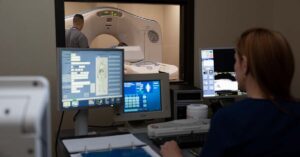24 Hour Full-Service Radiology Department
At Elite Hospital Kingwood, we provide emergency imaging and radiology which plays a pivotal role in the swift and accurate diagnosis of a myriad of medical conditions. These advanced diagnostic tools, ranging from X-rays to CT scans and ultrasounds, provide clinicians with a detailed view of the internal structures of the body, enabling them to detect fractures, internal injuries, infections, tumors, and various other abnormalities.
The immediacy of results often proves crucial in emergency scenarios, where timely interventions can mean the difference between life and death. Radiologists, the specialized physicians interpreting these images, collaborate closely with emergency room physicians to ensure that patients receive the most appropriate and expedient care based on the findings. As technology advances, the clarity, speed, and precision of emergency radiology continue to enhance the efficacy of urgent medical care.
All of our Radiologists are Certified and Licensed. We also offer the convenience of complete laboratory testing on-site, with results available for prompt diagnosis in less than an hour in most cases.
Radiology Services
On-Site Imaging
X-Ray
In an emergency setting, X-ray technology stands as a foundational diagnostic tool, enabling medical professionals to swiftly assess and diagnose a wide range of conditions. Its non-invasive nature allows clinicians to visualize the internal structures of the body, particularly bones, to identify fractures, dislocations, and infections. Beyond musculoskeletal issues, X-rays can detect lung conditions such as pneumonia or a pneumothorax, and they can also be instrumental in identifying foreign objects or obstructions within the body. The relative speed and simplicity of obtaining an X-ray in crucial moments make it an indispensable asset, providing immediate insights that guide treatment decisions. As emergencies often hinge on timely interventions, the rapid diagnostic capabilities of X-ray technology undeniably enhance the quality and effectiveness of urgent medical care.
CT Scan
The CT (Computed Tomography) scan emerges as an invaluable diagnostic tool in the emergency room, offering a detailed and multi-dimensional view of the body’s internal structures. This advanced imaging technique harnesses the power of X-rays to capture cross-sectional images of the body, which are then digitally compiled to create a comprehensive, 3D representation. Such intricate detail enables clinicians to promptly identify issues like internal bleeding, brain injuries, pulmonary embolisms, strokes, and fractures that might be elusive to conventional X-rays.
Given the time-sensitive nature of many emergencies, the CT scan’s ability to provide rapid, clear, and precise visuals is paramount, as it equips medical professionals with the critical insights needed to make informed decisions, thereby potentially saving lives and mitigating the In the high-paced environment of an emergency room, ultrasound technology offers a rapid, non-invasive, and versatile diagnostic solution. Often referred to as a “point-of-care” tool, ultrasound can be brought directly to a patient’s bedside, providing real-time imaging of internal structures. Its ability to visualize soft tissues distinguishes it from other imaging modalities like X-rays. This makes ultrasound particularly valuable for evaluating conditions such as gallstones, abdominal aortic aneurysms, ectopic pregnancies, and cardiac abnormalities. Additionally, its real-time feedback is crucial in procedures like guiding the placement of central lines or evaluating the progression of pregnancy. With no radiation exposure, ultrasound presents a safer alternative for certain patient populations, such as pregnant women. The immediacy and adaptability of ultrasound in emergency settings greatly enhance the diagnostic accuracy and subsequent management of myriad medical conditions.severity of various medical conditions.
Ultrasound
In the high-paced environment of an emergency room, ultrasound technology offers a rapid, non-invasive, and versatile diagnostic solution. Often referred to as a “point-of-care” tool, ultrasound can be brought directly to a patient’s bedside, providing real-time imaging of internal structures. Its ability to visualize soft tissues distinguishes it from other imaging modalities like X-rays. This makes ultrasound particularly valuable for evaluating conditions such as gallstones, abdominal aortic aneurysms, ectopic pregnancies, and cardiac abnormalities. Additionally, its real-time feedback is crucial in procedures like guiding the placement of central lines or evaluating the progression of pregnancy. With no radiation exposure, ultrasound presents a safer alternative for certain patient populations, such as pregnant women. The immediacy and adaptability of ultrasound in emergency settings greatly enhance the diagnostic accuracy and subsequent management of myriad medical conditions.
If you have questions about Imaging & Radiology, click the contact button below and speak to us for more information.

